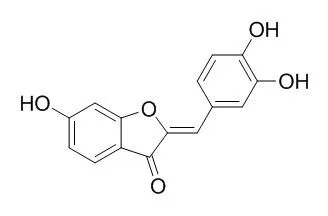| Description: |
Sulfuretin is a potent anti-oxidant, has protective effect against t-BHP-induced oxidative damage in human liver-derived HepG2 cells is attributable to its ability to scavenge ROS and up-regulate the activity of HO-1 through the Nrf2/ARE and JNK/ERK signaling pathways. Sulfuretin may have a potential role for neuroprotection, possibly through inhibition of phosphorylation of MAPK, PI3K/Akt, and GSK-3β, which leads to mitochondrial protection, NF-κB modulations and subsequent suppression of apoptosis via ROS-dependent pathwaysand, may be used as a therapeutic agent for PD; it also may have therapeutic value in preventing or delaying the progression of rheumatoid arthritis.Sulfuretin has therapeutical effect on leukemia, due to its potent apoptotic activity through the extrinsic pathway driven by a Fas-mediated caspase-8-dependent pathway. |
| In vitro: |
| Int J Mol Sci. 2014 May 19;15(5):8863-77. | | The cytoprotective effect of sulfuretin against tert-butyl hydroperoxide-induced hepatotoxicity through Nrf2/ARE and JNK/ERK MAPK-mediated heme oxygenase-1 expression.[Pubmed: 24857917] | Sulfuretin is one of the major flavonoid components in Rhus verniciflua Stokes (Anacardiaceae) isolates.
METHODS AND RESULTS:
In this study, we investigated the protective effects of Sulfuretin against tert-butyl hydroperoxide (t-BHP)-induced oxidative injury. The results indicated that the addition of Sulfuretin before t-BHP treatment significantly inhibited cytotoxicity and reactive oxygen species (ROS) production in human liver-derived HepG2 cells. Sulfuretin up-regulated the activity of the antioxidant enzyme heme oxygenase (HO)-1 via nuclear factor E2-related factor 2 (Nrf2) translocation into the nucleus and increased the promoter activity of the antioxidant response element (ARE). Moreover, Sulfuretin exposure enhanced the phosphorylation of c-Jun N-terminal kinase (JNK) and extracellular signal-regulated kinase 1/2 (ERK1/2), which are members of the mitogen-activated protein kinase (MAPK) family. Furthermore, cell treatment with a JNK inhibitor (SP600125) and ERK inhibitor (PD98059) reduced Sulfuretin-induced HO-1 expression and decreased its protective effects.
CONCLUSIONS:
Taken together, these results suggest that the protective effect of Sulfuretin against t-BHP-induced oxidative damage in human liver-derived HepG2 cells is attributable to its ability to scavenge ROS and up-regulate the activity of HO-1 through the Nrf2/ARE and JNK/ERK signaling pathways. Therefore, Sulfuretin could be advantageous as a bioactive source for the prevention of oxidative injury. | | Biochem Biophys Res Commun. 2013 Feb 15;431(3):572-8. | | Sulfuretin-induced miR-30C selectively downregulates cyclin D1 and D2 and triggers cell death in human cancer cell lines.[Pubmed: 23318178] | Sulfuretin (3',4',6'-trihydroxyaurone), one of the key flavonoids isolated from Rhus verniciflua, is known to suppress inflammation and oxidative stress. However, the anti-cancer properties of Sulfuretin as well as its mechanism of action remain poorly understood.
METHODS AND RESULTS:
Here, we show that the expression of miR-30C is markedly enhanced in Sulfuretin-stimulated cells, consequently promoting apoptosis and cell cycle arrest in human cancer cell lines. The transient transfection of pre-miR-30C resulted in greater than 70% growth inhibition in PC-3 cells and provided strong evidence that miR-30C selectively suppresses the expression of cyclin D1 and D2, but not cyclin D3. Target validation analysis revealed that 3'-UTR of cyclin D2 is a direct target of miR-30C, whereas suppression by miR-30C of cyclin D1 may occur through indirect mRNA regulation. In addition, silencing miR-30C expression partially reversed Sulfuretin-induced cell death.
CONCLUSIONS:
Taken together, our data suggest that miR-30C, a tumor suppressor miRNA, contributes to anti-cancer properties of Sulfuretin by negatively regulating cyclin D1 and D2, providing important implications of Sulfuretin and miR-30C for the therapeutic intervention of human cancers. | | J Cell Biochem. 2012 Sep;113(9):2835-44. | | Sulfuretin from heartwood of Rhus verniciflua triggers apoptosis through activation of Fas, Caspase-8, and the mitochondrial death pathway in HL-60 human leukemia cells.[Pubmed: 22492309] | Sulfuretin, a flavonoid isolated from heartwood of Rhus verniciflua, has been reported to have anti-cancer activities but the underlying molecular mechanism was not clear.
METHODS AND RESULTS:
In this study, Sulfuretin induced apoptosis by activating caspases-8, -9, and -3 as well as cleavage of poly(ADP-ribose) polymerase. Furthermore, treatment with Sulfuretin caused mitochondrial dysfunctions, including the loss of mitochondrial membrane potential (ΔΨ(m)), the release of cytochrome c to the cytosol, and the translocations of Bax and tBid. Sulfuretin also activated the extrinsic apoptosis pathway, that is, it increased the expressions of Fas and FasL, the activation of caspase-8, and the cleavage of Bid. Furthermore, blocking the FasL-Fas interaction with NOK-1 monoclonal antibody prevented the Sulfuretin-induced apoptosis.
CONCLUSIONS:
The therapeutical effect of Sulfuretin in leukemia is due to its potent apoptotic activity through the extrinsic pathway driven by a Fas-mediated caspase-8-dependent pathway. |
|






 Cell. 2018 Jan 11;172(1-2):249-261.e12. doi: 10.1016/j.cell.2017.12.019.IF=36.216(2019)
Cell. 2018 Jan 11;172(1-2):249-261.e12. doi: 10.1016/j.cell.2017.12.019.IF=36.216(2019) Cell Metab. 2020 Mar 3;31(3):534-548.e5. doi: 10.1016/j.cmet.2020.01.002.IF=22.415(2019)
Cell Metab. 2020 Mar 3;31(3):534-548.e5. doi: 10.1016/j.cmet.2020.01.002.IF=22.415(2019) Mol Cell. 2017 Nov 16;68(4):673-685.e6. doi: 10.1016/j.molcel.2017.10.022.IF=14.548(2019)
Mol Cell. 2017 Nov 16;68(4):673-685.e6. doi: 10.1016/j.molcel.2017.10.022.IF=14.548(2019)